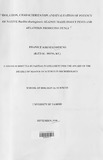| dc.description.abstract | Bio-control of pests using Bacillus thuringiensis represents the most potential use of
biological control agents to date. Among major constraints to maize production, safety
and hence food sufficiency in Kenya is infestation, damage and contamination by insect
pests. Maize grains are adversely damaged by Prostephanus truncatus which
occasionally paves way for the growth of aflatoxin producing fungi. A number of
management strategies have been employed for the control of maize insect pests
including the use of synthetic insecticides all of which however, have limitations. The
focus of this study was to isolate and establish the efficacy of native B. thuringiensis
against P. truncatus, Chilo partellus, Aspergillus jlavus and Aspergillus niger for use in
both pre-harvest and post harvest maize protection. The isolated B. thuringiensis strains
were classified according to their morphological appearance, growth and biochemical
characteristics. Based on the preliminary potency tests, isolates KG 411, KG 12-0, KG
20, KG 420, KM 31 and KM 24 caused over 50% mean mortality at the first
predetermined discriminate dose of 10 mg/m\. With subsequent log probit analysis KG
411 was significantly more toxic at 95% confidence limit (p <0.001) than all the other
isolates, with a median dose of 0.30 mg/ml causing 77.1% mean mortality. Log probit
analysis for toxicity of the native B. thuringiensis isolates on the second instar larvae of
C. partellus showed significant differences at 95% confidence limit (p<0.00 1), with
isolate KM 12causing the highest mean mortality of 76 %. Evaluation of effects of the B.
thuringiensis isolates against the above mentioned two fungal strains showed that isolate
KM 31 was the most inhibitory, causing 83.33 % and 78.33 % inhibition against A. niger
and A. jlavus respectively at 95% confidence (p < 0.001). In conclusion, this result
demonstrates the availability of novel native B. thuringiensis which would constitute an
alternative biological control option for management of adult P. truncatus, A. niger and
A. jlavus III both pre-harvest and post harvest maize protection. | en |

